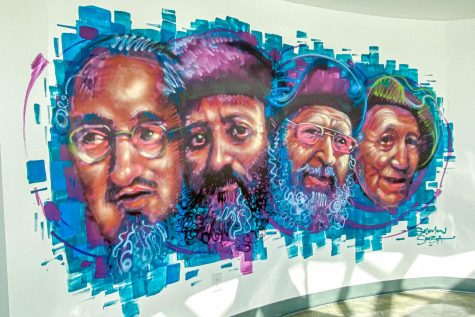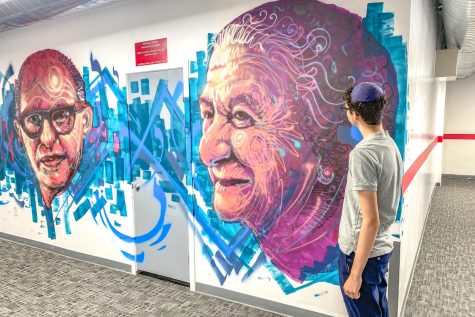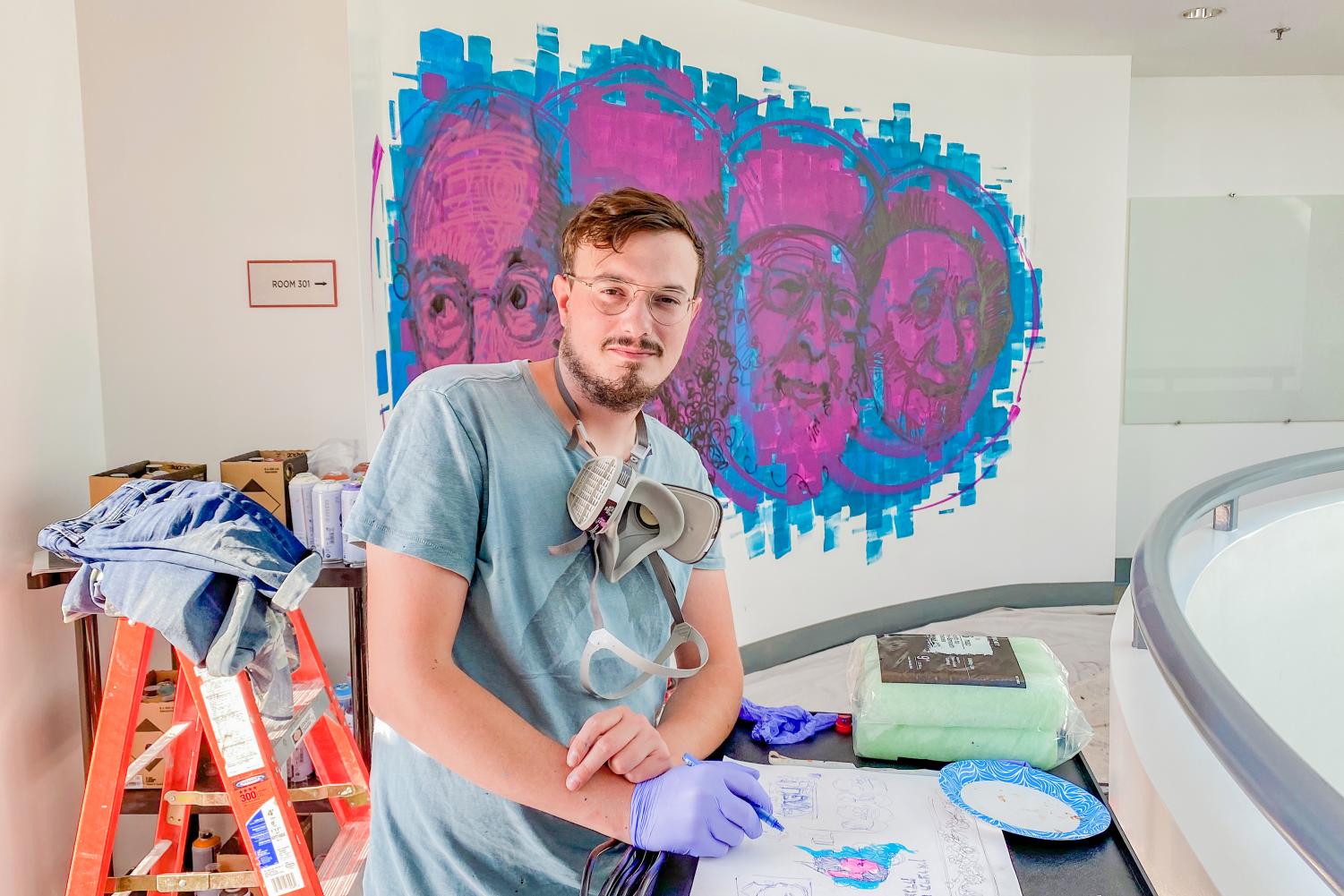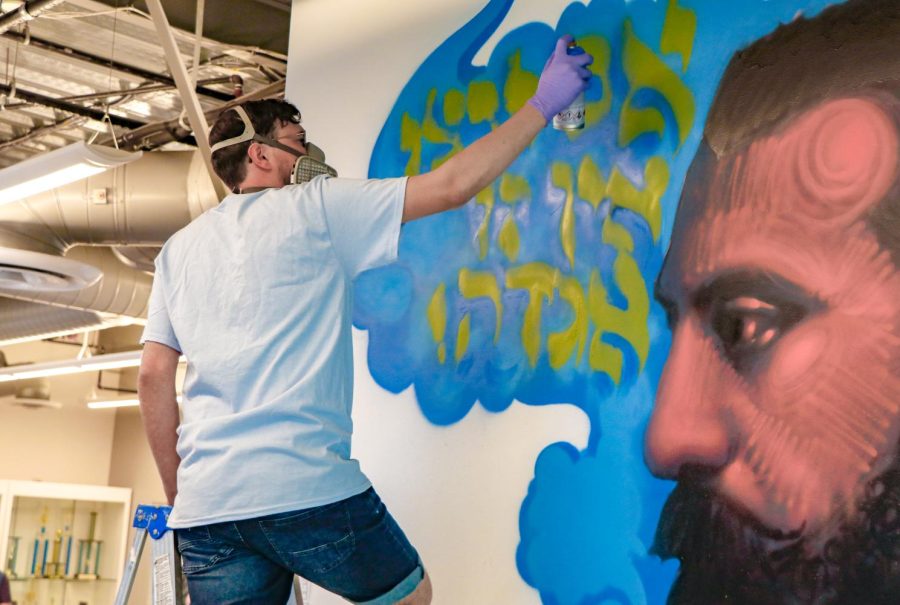Larger than life, portraits in undulating colors now brighten hallways
Solomon Souza, famous for Machane Yehudah murals in Jerusalem, spent two weeks decorating the white walls at Shalhevet
November 19, 2022
When students walked into Shalhevet last August, they didn’t expect to be greeted with vibrant, oversized but lifelike, graffiti-sprayed street art.
But during the last two weeks of summer break, the British-born and internationally famous Israeli artist Solomon Souza transformed the walls of the basement, cafeteria and various places on the third floor with gigantic murals of Israeli pioneers and Jewish figures, along with one non-Jewish figure, in an array of undulating shapes and expressive colors.
“We wanted to revitalize the basement, and really make it beautiful, and make it cool, and that’s kind of how it started,” said Shalhevet’s Chief Operating Officer, Ms. Sarah Emerson.
“I did not see the third floor happening. I will call it kind of an organic evolution.”

Organic is a good word to describe Souza’s art – which, apart from its size, seems way too lifelike to be made from the materials used to gang-tag billboards, buildings and bus stops. Mr. Souza is best known for spray-painting murals of Israeli leaders on the sliding metal doors that cover stalls in Jerusalem’s Machane Yehuda market after hours. He has painted more than 250 of them so far.
At Shalhevet, he painted the faces of David Ben Gurion, Menachem Begin, Hannah Senesh and Golda Meir – heroes of the early history of modern Israel – stretching out along the wall opposite Rooms B101 and B103. In shades of reds, blues and dark purples, eye-catching details bring the pioneers to life; lines and other details in their faces make them appear three-dimensional while their size dwarfs students passing by.
Inside Room B103, a spray-paint portrait of the Lubavitcher Rebbe, Rabbi Menachem Mendel Schneerson, overlooks the room used for Mishmar, each of his eyes as big as a person’s fist. The Rebbe appears on a blue background, his right arm in the air.
On the first floor, Theodore Herzl greets students at the entrance to the cafeteria, surrounded by bright orange and blues. Above him is his own most famous quote, Im tirzu ein zo agada, – if you will it, it is no dream.
In the third-floor stairwell landing, Rav Joseph Soloveichik, Rav Abraham Isaac Kook, Rav Ovadiah Yosef and the scholar Nechama Liebowitz peruse the scene together from the curved white wall. These revered 20th-century scholars and religious leaders are painted closely together with just their faces, each staring in a different direction, detailed in purple on a background of deep blue.
Elsewhere on the third floor is the one non-Jew in the set – Abraham Lincoln, in Room 308, where Dr. Keith Harris teaches history and SAS Civil War. Approximately seven-and-a-half feet tall, it reaches almost floor-to-ceiling on the wall beside rows of blue chairs and white desks. Lincoln’s hat covers nearly half of the wall, and blue and white stars surround him. A red ribbon ducks below his collar.
Sophomore art student Leah Cohen immediately had already noticed Abraham Lincoln’s presence in her history classroom when Mr. Souza visited her 10th-grade Composition and Design art class, taught by Ms. Sam Garelick, during the first week of school when he was still on campus.
“He was telling us about his journey through art and how he started,” Leah said, “and how he started the initiative to paint art on the doors of the shuk stalls that are closed, and it’s just so amazing.
“You can tell every aspect of the faces on all of the murals. It’s crazy.”
Mr. Souza had painted at Shalhevet before – the abstract fish-and-blue-bubbles mural near the turf outside the stairway lobby on the roof, which he created in 2017.
Since then, he has become one of the most famous artists in Israel and also has designed countless murals and canvasses all around the world.
“How cool would it be if he could come?” Ms. Emerson said.
Due to Covid, the basement hadn’t been used for two years due to a lack of adequate ventilation. When Ms. Emerson and Rabbi Block decided it was time to put it back into use, they first considered wallpaper, but Ms. Emerson had remembered Mr. Souza.
Rabbi Block and Ms. Emerson knew they wanted faces from Israeli history, but beyond that she said, the project grew on its own.
As a 29-year-old full-time artist, Souza’s day-to-day life generally consists of painting canvases in his studio or painting walls in the streets. He is most known for his paintings on the shutters in the Jerusalem shuk that can be seen after hours. Out of 360 shutters in the shuk, Souza has so far painted more than 250 of them. During the process, he was painting around four shutters per night, each one taking a few hours.
On the Tuesday before school started, Aug. 23, Mr. Souza was taking a break from his third-floor painting. He stepped outside to get some fresh air and left his paint and tools behind.
His process, as he told the Boiling Point, begins with picking a character and then finding shapes within the image.
“Well first we pick the character, or the subject,” Mr. Souza said, “then well, you know, images, really everything is made out of shapes, an image is made out of shapes, especially 2-D static image right?
“And you just basically have to find the shapes, and the tones, the shapes of color, it’s basically whatever makes up an image. There’s different shapes and angles of colors, and you have an image!”
AUDIO: Hear Solomon Souza, interviewed by Olivia Fishman, describe his process
He said he most often uses blues and turquoise in his work because they’re his favorite colors.
He said he sometimes sketches his work before he begins, but not always. For his paintings in Shalhevet, he began with a layer of acrylic paint and then spray-painted the details and specifics of each painting. His main medium is typically spray paint.
“It’s a slow process of finding those shapes and refining them,” Mr. Souza said. “My style has gotten a lot looser over the years, so it used to be like — it’s getting better.” He began his work in the Shalhevet basement and soon realized that only four figures would fit on the large wall. Four didn’t seem like enough, however, so Souza, along with Ms. Emerson and Rabbi Block, scanned the halls for other places to add artwork.
Thematically, Herzl was removed from the basement because he didn’t fit in quite as well with the other basement pioneer-like figures.
“We didn’t want it to be in a place that was distracting, or where it would feel a little funny or weird to have someone staring at you,” Ms. Emerson said. The stairwell was a topic of discussion, but administrators decided that paintings on the stairwell would ruin the clean look that one sees when entering Shalhevet. After searching, the cafeteria was chosen for Herzl.
Meanwhile, outside in the parking lot was a wooden gate at the northeast corner along Orange Street, which had been brightly painted with Herzl’s words im tirzu ein zo agada – if you will it it is no dream – soon after it was built. For safety reasons, this gate was recently replaced with an iron gate that could not hold a mural – so the quote that had been on the gate can now be seen above Herzl in the cafeteria.
Ms. Emerson and Rabbi Block decided that it would be appropriate to have a mural of Torah giants as well, so four influential figures landed next to the college counseling suite on the top of the staircase.
Also on the third floor, when Dr. Harris saw Souza painting around the school, he asked to add Abraham Lincoln to the wall in his classroom. According to Ms. Emerson, the administration fulfilled his wish because it was a big enough classroom with proper lighting for the painting to have the right effect.
Reaction to the murals has been mostly positive, though some say they wish more General Studies subjects were represented, and a few find the faces too big. Several students favored the Lincoln (7½ feet tall) and Lubavitcher rebbe (5 feet, 10 inches) murals, which are the two smallest ones.
Senior Jack Metzger notices the murals wherever he walks around school.
“The art is really beautiful, and it brings a more colorful aspect to this community that people will appreciate as they walk by, instead of the white walls that we usually see,” said Jack.
Sophomore Mikayla Namvar agreed that this addition to the building is colorful.
“I like it a lot,” said Mikayla. “It adds a nice touch to our school and is very creative.”
Criticisms of the murals fell into two categories – size and subject matter. Rabbi Abraham Lieberman wished there were more on General Studies subjects.
Rabbi Lieberman said that based on what Shalhevet prioritizes, it could have incorporated secular philosophers and scholars, as well.
“We are a school that is Torah u’mada,” Rabbi Lieberman said, using the Hebrew idiom for Torah combined with secular knowledge. “So we’ve captured the Torah people there. We’ve captured some Zionists. So it captures the Jewish soul of the school.”
“But in our school, we also do study and value secular studies, so there might be a way in a positive way to incorporate some great thinkers out there who we study in school, who influence our modern world of General Studies.”
Asked to respond, Rabbi Block acknowledged the importance of secular thinkers’ presence in the school but said that Mr. Souza’s “signature genre” focuses on “Israeli landscapes, scenes from vibrant Israeli life, and portraits of Israeli and Jewish personalities.”
“Solomon is a Jewish/Israeli artist,” Rabbi Block wrote, referring to Mr. Souza, in an email response to Boiling Point questions, and though he can paint other things, “portraits of Israeli and Jewish personalities is part of what makes him so unique, and that’s what we wanted to capture.”
He concluded his email by saying that work is in progress to incorporate “new voices and thinkers from the world generally” into the project, and are working on a plan for how to proceed.
No one expressed dislike of the colorful images, but several students thought they were too large. People would only describe such views on the condition of anonymity.
“It doesn’t match anything else in the school,” said a senior who didn’t want his name used because the comment was critical.
Another senior, anonymous for the same reason, said, “These portraits are very large, and the size of them overpowers the vibe of the school.”
A freshman who would speak only without using his name seemed to agree with what the seniors thought of the paintings.
“They’re sort of out of place, I feel,” the freshman said. “They’re large and bright and distracting.” That student’s favorite piece is The Lubavitcher Rebbe in Room B103 because it’s smaller and less noticeable than others around the school, he said.
Junior Zion Schlussel liked the new art and had some favorites.
“I like the Abraham Lincoln in Dr. Harris’s room, and there’s one of the Rebbe downstairs in the basement,” Zion said. “I saw it once, and it was really cool.”
In his August interview, Mr. Souza described how he became a professional artist. He doesn’t think he has special talent, and he thinks students should not give up on their creative passions.
“I think that we’re all capable,” Souza said. “I think everyone with hands and eyes and a brain can learn the techniques I use to create art. It’s just a technique, that’s it. Anyone can replicate a technique.”
He thinks “talent” is more about passion. “The idea of talent is maybe the desire to do that subject – to do that,” he said. “I like painting so I paint – that’s the talent, because I like it.”
Mr. Souza wanted to go to art school to pursue his career. But his mother begged him not to because, he said, “she’s an artist herself and she went to art school, and she said it killed her [art] basically.”

Instead, Mr. Souza was encouraged to dive deeper into his art on his own, with the freedom available for his creativity to flourish.
He said he understood the necessity students may feel to explore a different kind of career, but he wishes more would stay with what they love. Children, he said, love to be creative, “and then they kind of slowly drift away from it as they get older, and they focus on other things.”.
“You get voices in your head, and some of them you should listen to more sometimes, like your creativity – it’s a sacred kind of place,” Mr. Souza said. “And where you find that access to your creative space in your mind, you have to guard it.”
The artist’s ultimate wish for students is for them to chase after their passions and never let them go.
“Even if you move on from art – you move to other things, whatever — it’s a sacred thing, and it needs to be developed and adapted,” Mr. Souza said.
“It deserves focus; it will help you in many many avenues in life, even if you don’t want to be a painter, an artist, for a profession. You can take it with you wherever you go.
This story won national 2023 Multimedia Photo Slideshow of the Year, Honorable Mention, and 2023 Feature Photo of the Year, Honorable Mention, from the National Scholastic Press Association (NSPA). It also won a 2023 Simon Rockower Award from the American Jewish Press Association, Honorable Mention Award for Excellence in Arts News & Features Reporting; and First Place in Photojournalism in the 2023 Jewish Scholastic Journalism Awards of the Jewish Scholastic Press Association.
test2
Nine towering faces. Who are they?
In a written response to Boiling Point questions, Rabbi Block explained how school officials chose which Jewish figures should be pictured in Solomon Souza’s new murals.
Originally, as part of our attempt to revive the wonderful space in our basement so that we can use it to its fullest potential, we sought to make it more attractive and vibrant. Solomon, as an Israeli artist and someone with whom we have a long standing relationship, was primarily brought in to paint a mural of Israel leaders on the basement walls. David Ben Gurion, Chanah Senesh, Menachem Begin, and Golda Meir now beautifully and powerfully adorn that space.
During his visit, he also painted a Theodore Herzl (with his famous saying of Im Tirtzu) – both because of its inherent value in our Zionist school, and because we had to replace the outer gates in our parking lot that used to have that quote.
Leading up to our 3rd floor Beit Midrash, he painted some Torah personalities of the last generation that have profound impact on our general hashkafa and our Torah learning approach: Rav Yosef Soloveitchik, the most influential and leader and thinker of Modern Orthodoxy; Rabbi Abraham Isaac Kook ,an extremely important voice for Torat Eretz Yisrael and for the true love of all Jews, or ahavat yisrael; Rabbi Ovadia Yosef the great Sephardic posek and halachist; and Morah Nechama Leibowitz, one of the most important Tanach thinkers, leaders and teachers, and someone who has profoundly impacted our learning and teaching methodology.
Each person also represents a different area of Torah:
R’Soloveitchik – machshavah/hashkafa (thought and world view) — and his methodology of Gemara B’iyun (Talmud study)
R’ Kook, kabbalah and mysticism
R’ Yosef – halacha (Jewish law)
Morah Nechama – Tanach (and pedagogy generally).

